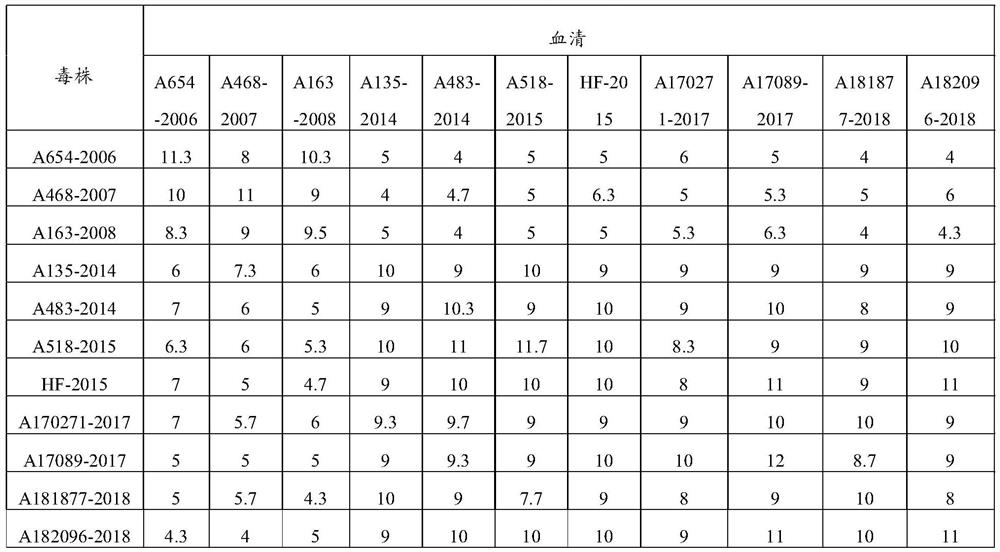H9 subtype avian influenza virus isolate and application thereof
An avian influenza virus and avian influenza technology, applied in the field of animal virology, can solve the problems of HA and NA antigenic changes, the decline of immune protection efficacy of vaccine strains, and immune failure, etc., and achieve good immune prevention, good cross-immunogenicity, Good effect on immunogenicity
- Summary
- Abstract
- Description
- Claims
- Application Information
AI Technical Summary
Problems solved by technology
Method used
Image
Examples
Embodiment 1
[0065] Isolation and identification of embodiment 1 virus
[0066] The low-pathogenic H9N2 subtype avian influenza virus has spread widely in my country. In recent years, chickens immunized with H9N2 subtype avian influenza vaccines have been infected with H9N2 subtype avian influenza and died, suggesting that the virus may drift through antigen Or the new epidemic trend of antigen transformation and evolution, which eventually leads to immune failure. Therefore, a large number of epidemiological investigations and researches were carried out on the mutation of the virus, and finally a strain of H9 was successfully isolated from a chicken farm in Hefei City, Anhui Province. Subtype of avian influenza virus.
[0067] 1.1 Isolation of virus
[0068] Select the diseased chickens with symptoms of respiratory system such as coughing and sneezing, bronchial embolism, tracheal mucosal edema, and pathological changes such as serous exudate, and get their internal organs (liver, kidney,...
Embodiment 2
[0089] Embodiment 2 is measured to chicken embryo and chicken pathogenicity
[0090] 2.1 Determination of half infection dose (EID50) of chicken embryo
[0091] The isolated virus was serially diluted 10 times with sterilized physiological saline, and 10 -1 ~10 -9 Inoculate 10-11-day-old SPF chicken embryos through the allantoic cavity with diluted virus liquid, 0.1ml / piece, inoculate 5 chicken embryos for each dilution, discard 24-hour dead embryos, and freeze overnight at 4°C 120 hours after inoculation For dead chicken embryos, the HA titer was measured embryo by embryo. If the HA titer was greater than 1:16, it was determined to be positive, and the virus EID was calculated by referring to the Reed-Muench method. 50 for 10 9.17 / 0.1ml.
[0092] 2.2 Toxicity to SPF chicken embryos
[0093] Dilute the HF strain E1 generation virus solution with sterilized physiological saline for 10 5 times, inoculate 10 10-day-old SPF chicken embryos through the allantoic cavity, 0.1m...
Embodiment 3
[0096] Example 3 Analysis of virus antigenicity
[0097] 3. Preparation of 1H9 single-factor serum
[0098] The 10 isolated strains of H9N2 subtype AIV and the HF strain involved in the present invention were used to prepare oil emulsion inactivated vaccines respectively. Immunize 21-day-old SPF chickens with the above-mentioned vaccines, 3 chickens for each vaccine, and carry out secondary immunization 14 days after the first immunization. Each time, 0.3ml of the vaccine is immunized through the leg muscles, and they are raised in a positive pressure isolator for poultry. 21 days after the second immunization, blood was collected aseptically, and the serum was separated to prepare single-factor positive serum, which was packed into small tubes and stored at -20°C.
[0099] 3.2 Determination of antigenic cross-reactivity between different strains
[0100] The 11 strains of H9N2 subtype AIV prepared in 3.1 were used to configure 4 units of antigen respectively, and then the h...
PUM
 Login to View More
Login to View More Abstract
Description
Claims
Application Information
 Login to View More
Login to View More - R&D
- Intellectual Property
- Life Sciences
- Materials
- Tech Scout
- Unparalleled Data Quality
- Higher Quality Content
- 60% Fewer Hallucinations
Browse by: Latest US Patents, China's latest patents, Technical Efficacy Thesaurus, Application Domain, Technology Topic, Popular Technical Reports.
© 2025 PatSnap. All rights reserved.Legal|Privacy policy|Modern Slavery Act Transparency Statement|Sitemap|About US| Contact US: help@patsnap.com



